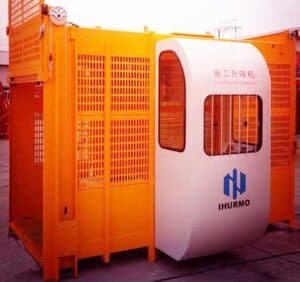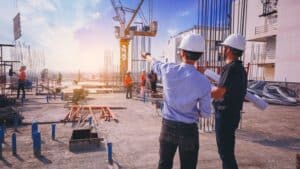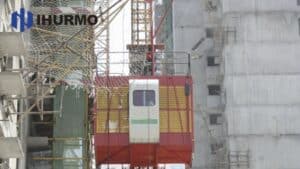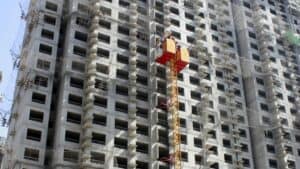Hoisting equipment plays a crucial role in construction, manufacturing, and various industries. There are several types of hoisting equipment, each designed for specific lifting tasks. From cranes to hoists and lifts, each type has unique features that cater to different needs.
Common applications include:
- Construction sites: Lifting beams, bricks, and machinery.
- Shipping yards: Moving containers and cargo.
- Factories: Handling heavy materials on assembly lines.
In this article, we will focus on exploring the different types and applications of hoists.
For readers seeking comprehensive information about cranes and lifts, our website features dedicated articles with analyses and practical insights.
To access these specialized resources, simply click the link below:
Hoists
Construction Hoist
Construction hoist, also known as construction elevator, are crucial for building sites. They are used to transport workers and materials vertically during construction.
These hoist can lift heavy loads. They are usually made of metal and are designed for durability.
Construction hoist are often temporary installations. They are installed on the side of a building and can be moved as construction progresses. Safety features, like guardrails and emergency brakes, are for worker protection.
Passenger & Material Dual-Purpose Hoists
2*2000 kg Double Cage Construction Elevator
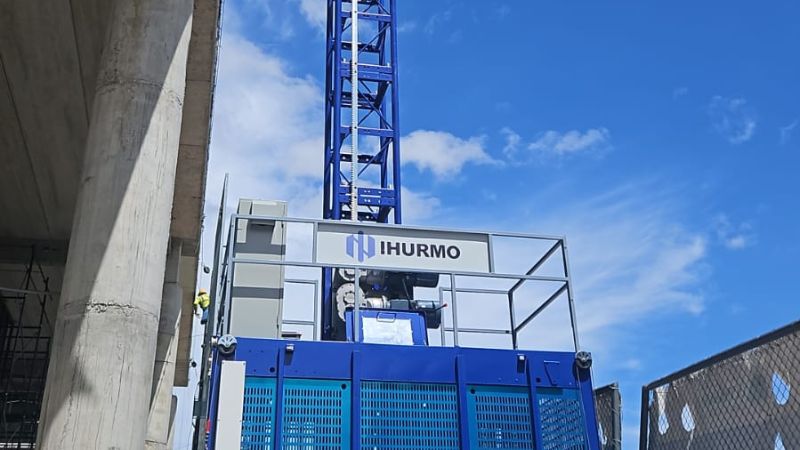
- Enhanced safety systems, including emergency brakes and overload sensors.
- Modular design for easy assembly and adaptability to building height changes.
- Compliance with international safety standards (CE, ISO).
Typical Applications:
- High-rise residential and commercial projects.
- Sites requiring simultaneous vertical movement of personnel and supplies.
- Projects prioritizing time efficiency and worker safety.
External Material Hoists
Double Cage Hoist for Building Construction
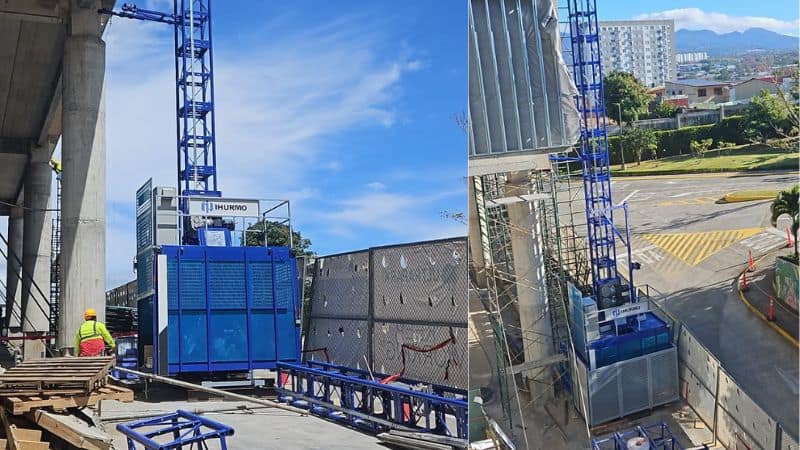
- Heavy-duty structure for transporting bulky materials (steel, concrete, equipment).
- Weather-resistant components for outdoor installation.
- High load capacity and stability in harsh conditions.
Typical Applications:
- Industrial construction sites requiring frequent material delivery.
- Projects with limited indoor space, necessitating exterior hoist installation.
- Transportation of oversized items like prefabricated panels or machinery.
Electric-Powered SC Series Hoists
Building Material Construction Hoist

- Precision electric motor systems for smooth operation and energy efficiency.
- Multiple load capacities (1.2T, 2T, 3T) to match project requirements.
- Advanced control panels with speed adjustment and real-time monitoring.
Typical Applications
- Mid- to high-rise buildings requiring consistent vertical logistics.
- Long-term construction sites needing reliable, low-maintenance equipment.
When selecting a construction hoist, consider:
- Load Requirements: Match capacity to material weight and frequency.
- Site Conditions: Opt for weatherproof models for outdoor use or compact designs for tight spaces.
- Project Duration: Temporary hoists for short-term needs vs. heavy-duty systems for multi-year projects.
- Safety Certifications: Ensure compliance with local regulations and global standards.
Explore our full range of Construction Hoists or contact our team for personalized recommendations. At Ihurmo, we elevate your construction efficiency—safely and sustainably. If you are considering to invest a construction hoist to your project, please contact us.
Manual Lifting Systems
Manual hoists, or chain blocks, operate through human-powered levers or hand chains. These devices employ dual chains: a hand chain for motion control and a load-bearing chain for weight support. Users activate lifting/lowering by manipulating the lever or alternating pulls on the hand chain.
Advantages include:
- Lower cost compared to powered alternatives
- Versatility across diverse lifting scenarios
- Independence from electrical power sources
Three subtypes dominate this category:
1. Lever-Style Manual Hoists
Featuring multi-angle swivel hooks and reinforced safety locks, these units enable horizontal and vertical lifts. Typical uses encompass pipeline alignment, structural straightening, and cable tensioning.
2. Chain-Driven Manual Hoists
Heavy-duty chains in these systems facilitate cargo positioning in industrial settings like shipyards, metallurgical plants, and aerospace maintenance facilities.
Electrically Powered Hoists
Motor-driven units replace manual effort with pushbutton control, utilizing chains, wire ropes, or synthetic belts for load movement. Applications vary by subtype:
1. Motorized Chain Hoists
Combining electric motors with alloy chains, these cost-efficient systems require minimal upkeep and simplify installation processes. Ideal for routine material transfers.
2. Motorized Cable Hoists
Steel wire ropes enable greater lift heights and heavier payloads than chain models, though reduced durability in specific environments and higher costs may be considerations.
3. Belt-Operated Electric Hoists
Sanitary designs make these suitable for contamination-sensitive sectors like food processing and pharmaceutical manufacturing, offering broad load capacity ranges.
Fluid-Powered Lifting Systems
Hydraulic Hoists
Utilizing pressurized oil rather than motors, these systems amplify force through piston mechanisms. Marine industries frequently deploy them for vessel launching/retrieval and container logistics.
Pneumatic Hoists
Compressed-air models excel in continuous operation scenarios where electric motors risk overheating. Three pneumatic subtypes serve specialized roles:
- Piston-Type Air Hoists: Generate linear motion through cylinder pressure differentials
- Air-Driven Chain Hoists: Spark-resistant designs for hazardous environments like chemical plants
- Pneumatic Cable Hoists: Moisture-resistant units with precision positioning for dusty or humid workspaces.
Mechanical Drive Hoists
Gear-Based Systems
Interlocking gear trains provide controlled lifting through torque multiplication, favored in construction and precision manufacturing for heavy load management.
Rotary Vane Hoists
Vacuum-driven units with rotating blades ensure delicate handling in automated packaging lines and assembly processes requiring damage-free transportation.
Cranes

Tower Cranes
Tower cranes are commonly used on construction sites. They have a tall, vertical structure that remains fixed in one location. They can reach great heights and lift heavy loads, making them ideal for building skyscrapers.
The operator controls the crane from a cab high above the ground. This design allows for a wide range of movement. Tower cranes can also rotate 360 degrees, which helps in reaching multiple areas on the site.
Mobile Cranes
Mobile cranes are versatile and easy to transport. They can move quickly from one job site to another. These cranes typically have a rotating superstructure and a boom for lifting.
Mobile cranes are equipped with wheels or tracks. This mobility enables them to operate in different terrains. They are commonly used for construction and maintenance tasks.
Elevators and Lifts
Scissor Lifts

Scissor lifts provide a stable platform for reaching high areas. They are commonly used in construction, maintenance, and warehouse activities.
The design includes crisscrossed metal supports, resembling a folding scissor. This allows the lift to extend vertically while maintaining stability.
Scissor lifts can reach heights of 20 to 50 feet. Most models can support a weight limit between 500 to 2,500 pounds. They are available in electric and diesel varieties, making them suitable for indoor and outdoor uses.
Boom Lifts
Boom lifts are versatile and can reach high places that other lifts cannot. They have an extendable arm, called a boom, that can articulate or rotate.
These lifts are ideal for tasks like window cleaning, building maintenance, and construction work. They come in various types, including telescopic and articulated, allowing for greater reach and maneuverability.
Boom lifts typically reach heights of 30 to 100 feet. They can support loads from 500 to 1,000 pounds. Using a boom lift provides flexibility in accessing hard-to-reach areas safely and efficiently.
Winches
Winches are important tools used for lifting and pulling heavy loads. They can be operated manually or powered by electricity or other sources. Each type has its own features and uses.
Hand Winches
Hand winches are operated by human strength. They are simple machines that use a crank to wind a cable or rope. These winches are ideal for lighter loads and small tasks.
Key Features:
- Lightweight and portable: Easy to move and transport.
- Cost-effective: Generally less expensive than powered options.
- Ideal for small applications: Great for boats, trailers, or home projects.
Using a hand winch requires some physical effort. They are useful in areas where power sources are not available.
Power Winches
Power winches use motors for operation. They can lift heavier loads with less effort compared to hand winches. These winches are often used in industrial settings or for larger projects.
Key Features:
- Higher lifting capacity: Can handle much heavier weights.
- Faster operation: Save time when lifting or pulling.
- Electric or hydraulic options: Choose based on specific needs.
Power winches are often more complex and may require installation. They are equipped with safety features like automatic brakes.
Cooperate With IHURMO
Forget cookie-cutter equipment, we specialize in custom-engineered hoists and tower cranes that adapt to your site’s challenges.
Our equipment arrives CE/ISO/ANSI-certified, and for the best part, premium doesn’t mean pricey.
By combining lean robotics-driven manufacturing with direct-from-factory pricing, we deliver equipment with affordable price. Contact us now, let’s build smarter.


